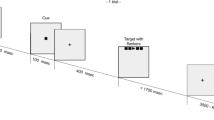Abstract
This study compares the effectiveness of the frequency-based recognition of short acoustic stimuli in groups of adolescents with attention deficit and normal measures of attention in conditions of the standard “oddball” paradigm. Stimuli of duration 50 msec yielded insignificant intergroup differences, though adolescents with attention deficit discriminated signal of duration 11 msec significantly worse. These showed significant differences in evoked brain potentials even with standard stimuli, with a significantly greater amplitude for N2b waves and a decreased P3b component. Evoked potentials obtained in response to the deviant stimulus were characterized by a P3b wave of reduced amplitude in the group with attention deficit. These data provide evidence that adolescents with attention deficit show defined abnormalities in the processing of acoustic sensory information at the cortical level.
Similar content being viewed by others
REFERENCES
A. A. Aleksandrov M. E. Babanin (2000) ArticleTitleMismatch negativity in evoked potentials using short-duration acoustic stimuli Fiziol. Cheloveka 26 IssueID6 161–165
A. A. Aleksandrov N. V. Karpina L. N. Stankevich (2002) ArticleTitleMismatch negativity in evoked potentials in the brain in normal adolescents and in attention deficit on presentation of short-duration acoustic stimuli Ros. Fiziol. Zh. im. I. M. Sechenova 88 IssueID3 281–286
A. V. Baru G. V. Gershuni I. M. Tonkonogii (1964) ArticleTitleThe significance of the detection of sound signals of different durations for the diagnosis of impairments to the higher parts of the brain Zh. Nevropatol. Psikhiatr. 64 IssueID4 481–485
G. V. Gershuni (1963) ArticleTitleEvoked potentials and the mechanisms discriminating external signals Zh. Vyssh. Nerv. Deyat. 13 IssueID5 882–890
F. X. Castellanos J. N. Giedd W. L. March S. D. Hamburger A. C. Vaituzis D. P. Dickstein S. E. Sarfatti Y. C. Snell N. Lange (1996) ArticleTitleQuantitative brain magnetic resonance imaging in attention-deficit hyperactivity disorder Arch. Gen. Psychiatr. 53 607–616
H. Enoki S. Sanada H. Yoshinaga E. Oka S. Ohtahara (1993) ArticleTitleThe effects of age on the N200 component of the auditory event-related potentials Cogn. Brain Res. 1 171–167
P. A. Filipek M. Semrud-Clikeman R. J. Steingard P. F. Renshaw D. N. Kennedy J. Biederman (1997) ArticleTitleVolumetric MRI analysis comparing subjects having attention-deficit hyperactivity disorder with normal control Neurology 48 589–601 Occurrence Handle1:STN:280:ByiB3MjoslU%3D Occurrence Handle9065532
Y. Frank J. A. Seiden B. Napolitano (1998) ArticleTitleElectrophysiological changes in children with learning and attentional abnormalities as a function of age: event-related potentials to an ‘oddball’ paradigm Clin. Electroencephalogr. 29 IssueID4 188–193
P. J. Holcomb P. T. Ackerman R. A. Dykman (1986) ArticleTitleAuditory event-related potentials in attention and reading disabled boys Int. J. Psychophysiol. 3 IssueID4 263–273
S. J. Johnstone R. J. Barry (1996) ArticleTitleAuditory event-related potentials to a two-tone discrimination paradigm in attention-deficit hyperactivity disorder Psychiatr. Res. 64 IssueID3 179–192
S. J. Johnstone R. J. Barry J. W. Anderson J. W. Coyle (1996) ArticleTitleAge-related changes in child and adolescent event-related potential component morphology, amplitude and latency to standard and target stimuli in an auditory oddball task Int. J. Psychophysiol. 24 IssueID3 223–238
S. J. Johnstone R. J. Barry J. W. Anderson (2001) ArticleTitleTopographic distribution and developmental time course of auditory event-related potentials in two subtypes of attention-deficit hyperactivity disorder Int. J. Psychophysiol. 42 73–94
C. Kemner M. N. Verbaten H. S. Koelega J. K. Buitelaar R. J. Gaag Particlevan der G. Cammferman H. England Particlevan (1996) ArticleTitleEvent-related potentials in children with attention deficit and hyperactivity disorders. Effects of stimulus deviancy and task relevancy in the visual and auditory modalities Biol. Psychiatr. 40 522–534
I. Lazzaro J. Anderson E. Gordon S. Clarke J. Leong R. Meares (1997) ArticleTitleSingle trial variability within P300(250–500 ms) processing window in adolescents with attention deficit hyperactivity disorder Psychiatr. Res. 73 IssueID1 91–101
R. D. Oades (1998) ArticleTitleFrontal, temporal and lateralized brain function in children with attention-deficit hyperactivity disorder: a psychophysiological and neurophysiological viewpoint on development Behav. Brain Res. 94 IssueID1 83–95
J. A. Sergeant C. A. Scholten (1983) ArticleTitleA stages-of-information approach to hyperactivity J. Child Psychol. Psychiatr. 24 IssueID1 49–60
N. Wada Y. Yamashita T. Matsuishi Y. Ohtani H. Kato (2000) ArticleTitleThe test of variables of attention (TOVA) is useful in the diagnosis of Japanese male children with attention deficit hyperactivity disorder Brain Dev. 22 IssueID6 378–382
Author information
Authors and Affiliations
Additional information
Translated from Rossiiskii Fiziologicheskii Zhurnal imeni I. M. Sechenova, Vol. 89, No. 7, pp. 769–775, July, 2003.
Rights and permissions
About this article
Cite this article
Aleksandrov, A.A., Polyakova, N.V. & Stankevich, L.N. Evoked brain potentials in adolescents in normal conditions and in attention deficit during solution of tasks requiring recognition of short-duration acoustic stimuli. Neurosci Behav Physiol 35, 153–157 (2005). https://doi.org/10.1007/s11055-005-0058-5
Received:
Issue Date:
DOI: https://doi.org/10.1007/s11055-005-0058-5




